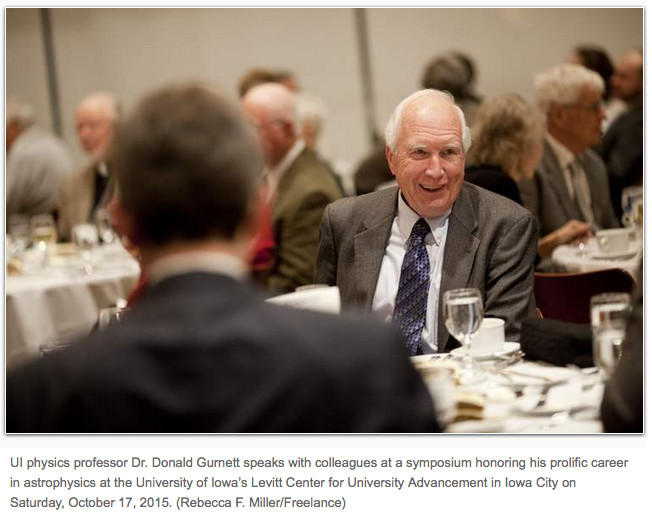Web Note: The Cedar Rapids Gazette recently chronicled the career of Distinguished Engineering Alumni Academy member Donald Gurnett (BSEE 1962)
By Vanessa Miller
Cedar Rapids Gazette
At an early age, it was pretty obvious — Don Gurnett was a natural.
He was enamored by model planes and rockets and, as young as age 10, got involved with an adult model airplane club in Cedar Rapids.

After graduating from St. Patrick’s High School in Fairfax in 1957, Gurnett headed to the University of Iowa to launch what would become a 58-year partnership in education and research that would shape the world’s knowledge of the universe and alter what students everywhere read in books.
Gurnett — who has been involved in 41 space missions, nearly two-thirds of UI’s 67 spacecraft projects, including Voyager I and 2, Cassini, Mars Express and Juno — recently was honored for his 50 years of employment with the university.
“I can’t imagine what our field would be like without Don Gurnett,” said Jim Green, planetary science division director for NASA and one of Gurnett’s many students who went on to work for NASA in some capacity.
“He has really pioneered a set of observations that we now know are so critical in our understanding of the environment around the earth and many of the planets in our solar system,” Green said in a UI tribute to Gurnett.
But Gurnett’s relationship with UI started long before his official employment as an assistant professor 50 years ago. Shortly after he stepped on campus a freshmen in 1957, the Soviet Union launched sputnik I, Earth’s first artificial satellite. A few months later, the United States launched its first satellite, Explorer 1.
UI Professor James Van Allen had an instrument on Explorer that detected what would be called the Van Allen radiation belt.
“I was so enamored with these events that I went in, in April, to (Van Allen’s) office to ask him for a job, to ask him if I could help him,” Gurnett said. “About a month later, I got a handwritten note from Van Allen inviting me to work in his group.”
That, Gurnett said, was a big deal.
“This was the beginning of the Space Age, and the University of Iowa was first,” he said.
In fall 1958, Gurnett took his first job at UI as a student employee, working on spacecraft electronics with Van Allen. His first project was to test and develop a charged particle detector that flew on the S-46 spacecraft.
“That rocket didn’t’ work,” Gurnett recalled. “It went into the ocean. And that pretty much is the sum of the story of my early space era.”
But Gurnett didn’t get frustrated and his space fascination didn’t waver. And in 1965, having earned his master’s and doctorate degrees from UI, Gurnett took a job in the Department of Physics.
Before landing the gig, Gurnett helped develop instruments that flew on seven spacecraft. Once a professor, Gurnett kept busy with a full workload of students, research, and space missions, collaborating on nine projects in the decade between 1967 and 1976.
But 1977 brought what Gurnett still considers to be his crowning achievement — the launch of Voyager 1 and 2. Gurnett was principal investigator for a plasma wave system on the mission, which took advantage of favorable planetary alignment and completed the “grand flyby” of Jupiter, Saturn, Uranus and Neptune.
The mission was extended three times, and in 2012 Voyager I became the first human-made object to enter interstellar space. That, Gurnett said, is farther than any human-made object has traveled — about 130 astronomical units from Earth.
One astronomical unit is the distance from Earth to the sun, Gurnett explained. A radio signal from Voyager I takes about 18 hours to transmit. The same signal would take about one second to send to Earth from the moon, according to Gurnett.
“My instrument showed we got there — to interstellar space,” Gurnett said.
His career accomplishments also include recording the first sounds in space as well as collaboration on NASA’s Juno mission, which launched in 2011 and is on track to reach Jupiter in July 2016. Gurnett, 75, has a hand in nine space missions currently flying and carrying operating instruments.
Those include Mars Express, a multinational project led by the European Space Agency aimed at studying the Martian atmosphere and climate, along with the planet’s structure and geology.
That mission, in part, is searching for water on Mars, which Gurnett said could indicate the potential for life on that planet. And that question, he said, is a significant one in the future of space exploration and discovery.
“The search for life is an extremely important question,” Gurnett said. “That is going to be the focus in the next few years.”
Science and technology advancements have enabled significant discovery since Gurnett’s career began, but he expects continued and accelerated space innovation.
“There is a tremendous amount to be learned about the universe,” he said.
That is why, Gurnett said, he’s always viewed educating younger researchers as equal in importance to his space science and experiments. Students over the years consistently have rated Gurnett among the best teachers in the department, according to his colleagues.
“It’s very important,” Gurnett said of his teaching, boasting about the 45 master’s or doctoral students he advised over the years. “Almost immediately I began having graduate students work on projects.”
In anticipation of a public symposium that celebrated Gurnett last month, UI physics and astronomy professor Robert Mutel likened his colleague to the man who first fanned his scientific flames.
“Professor Gurnett perfectly embodies the legacy of his mentor, James Van Allen — brilliant but unpretentious, hardworking, completely dedicated to his students and colleagues and to the University of Iowa,” Mutel said.